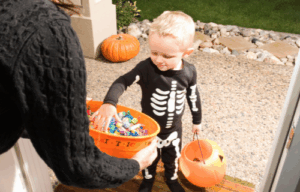Many children look forward to Halloween all year long, but it can be an overwhelming holiday for children with autism spectrum disorder (ASD) and other sensory disorders. Scary decorations, loud noises, uncomfortable costumes, and nighttime trick-or-treating can be a lot to handle. We have some fun ideas to help create a fright-free Halloween for your family.
Halloween Costume Ideas for Children with Autism
Costumes can often be uncomfortable for children and teens with autism because of sensitivity to fabrics and temperature. Here are some tips to ensure a comfortable and enjoyable costume experience for your child:
Consult Your Child: Ask your child what they want to wear. They are likely more willing to wear a costume that aligns with their preferences.
Prioritize Comfort: Avoid costumes with masks, tight collars, itchy seams, or face paint, as they can trigger texture sensitivities. Have your child try their costume on in advance and practice wearing it.
Consider Adaptive Costumes: Retailers like Target offer adaptive Halloween costumes, designed for children with disabilities and their needs.
DIY Costume Options: Create a costume by pairing everyday attire or pajamas.
 Here are some sensory-friendly costume ideas:
Here are some sensory-friendly costume ideas:
- Superhero-themed t-shirt with comfortable pants
- Skeleton pajama set
- Black cotton dress and DIY-painted cat’s face
- Disney princess nightgown
- Animal onesie
Sensory-Friendly Halloween Activities
Check your local community calendar for autism-friendly events in your area. Community centers, churches, schools, and zoos often organize Halloween-themed events and trick-or-treating. Below are a few ideas for how to create sensory-friendly activities at home:
Halloween-Themed Sensory Bin: Create a sensory bin filled with Halloween-themed toys such as orange kinetic sand, spiders, vampire teeth, and slime for tactile play.
Halloween Scavenger Hunt: Organize a scavenger hunt with Halloween-themed decorations including a pumpkin, ghost, and spider webs around your home or neighborhood. This is a great way to involve other friends and family members.
Halloween Baking: Make Halloween-themed treats together as a family, promoting sensory engagement and motor skills development through cooking.
Arts & Crafts: Encourage your child’s creativity with Halloween-themed arts and crafts projects.
Trick-or-Treating Tips for Children with Autism
To make trick-or-treating a more comfortable experience for your child with autism, we recommend trying one of these tips:
Visual Teaching Story: Explain the concept of trick-or-treating through a visual teaching story to help your child understand what to expect. For example, show your child photos of pumpkins, children dressed in costumes, and buckets of candy to represent what takes place on Halloween.
Fun with Friends & Family: Go trick-or-treating with individuals your child is familiar with to create a supportive environment.
Start Early: Begin trick-or-treating earlier in the evening before it gets dark to reduce sensory overload.
Noise Reduction: Carry headphones or earplugs to minimize sensory stimulation during trick-or-treating.
Embrace a sensory-friendly Halloween using these tips to create an experience that is enjoyable and stress-free for your child with autism.
At Surpass Behavioral Health, we are passionate about making a positive difference in the lives of our clients and families. Our focus is quality care that you can trust. We believe in our clients’ ability to achieve their goals and we want to celebrate each win together. Our mission is for our clients to be successful across a variety of settings and provide support to our families.
Learn more about our services or find a clinic near you.


